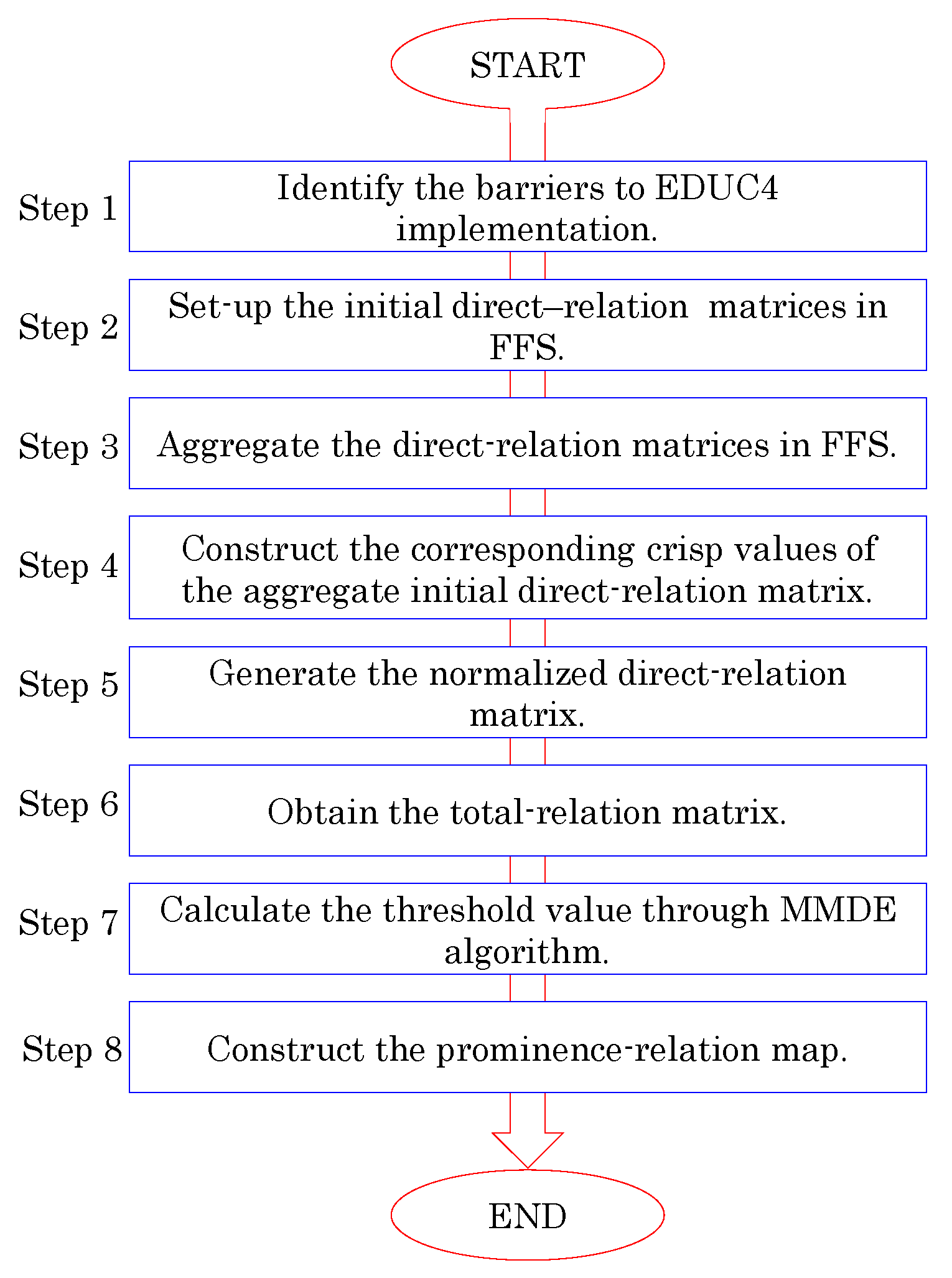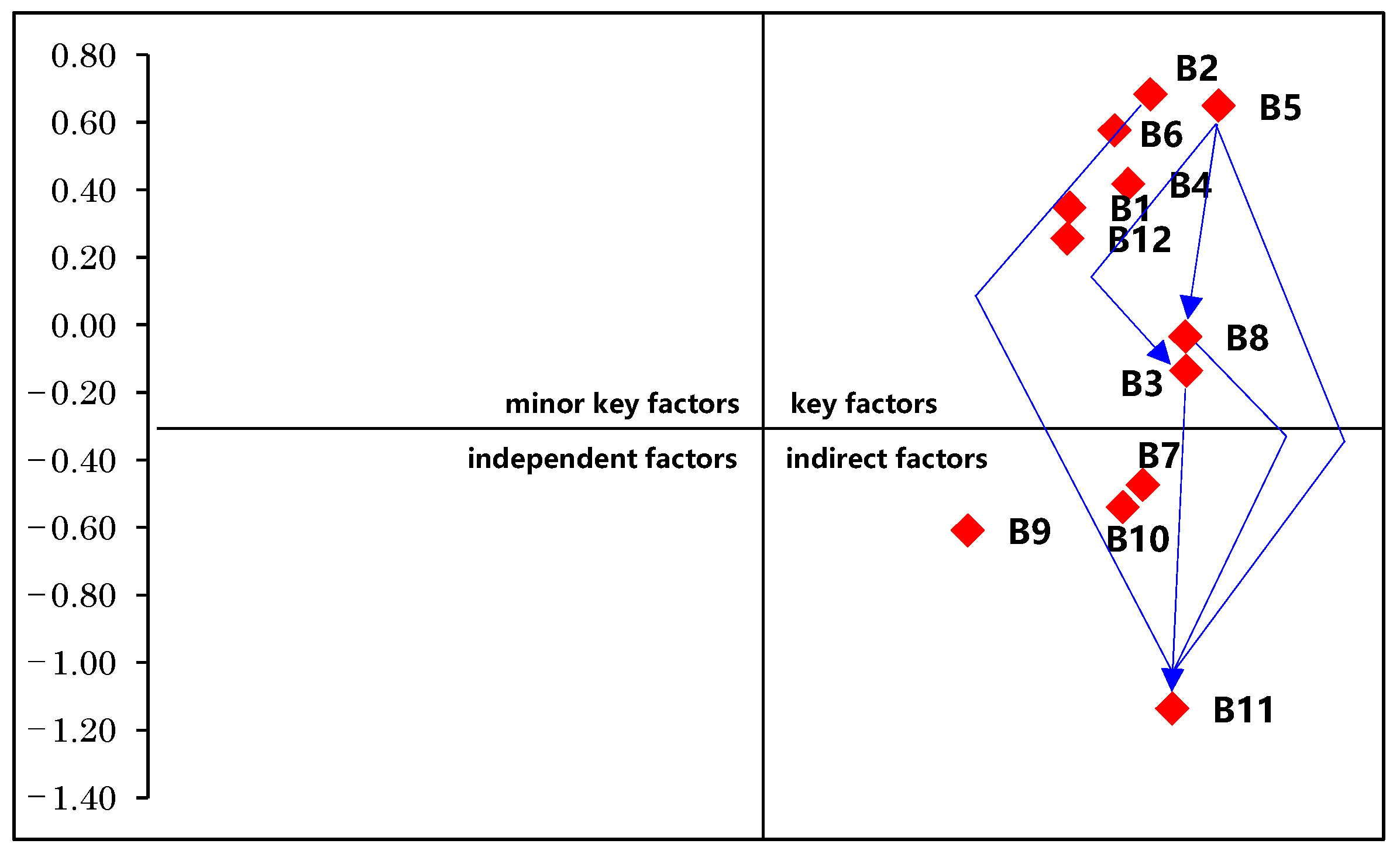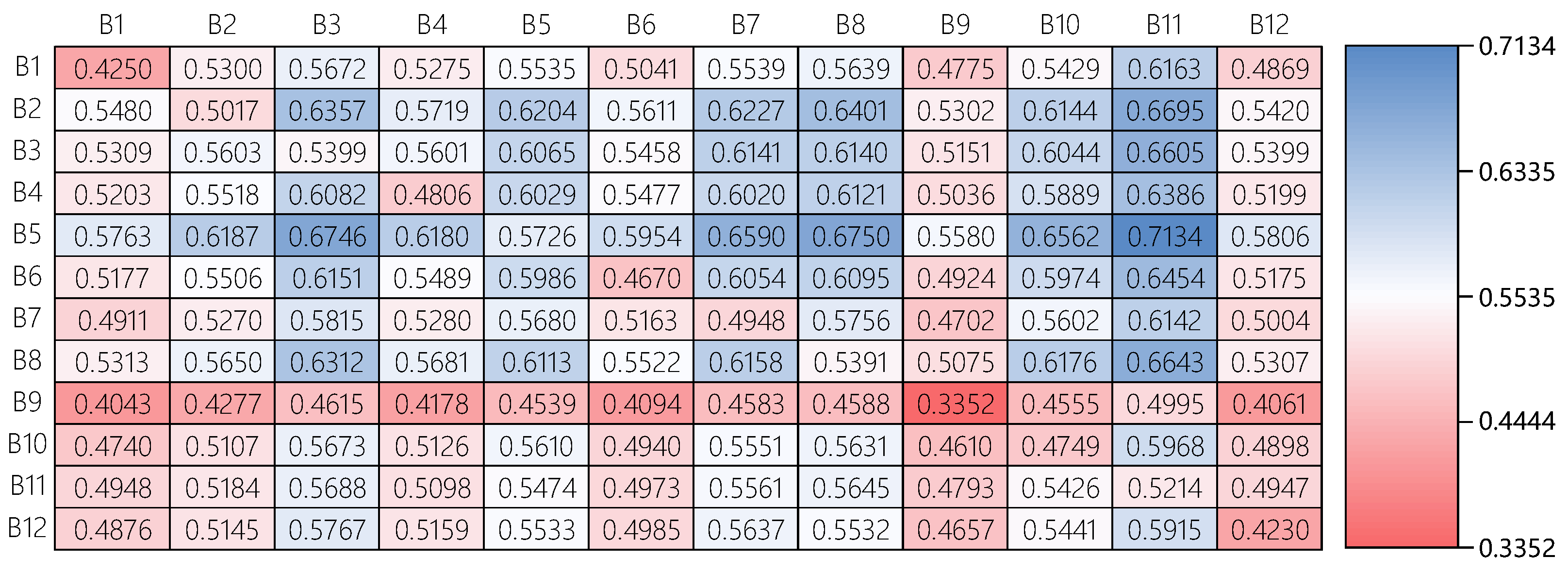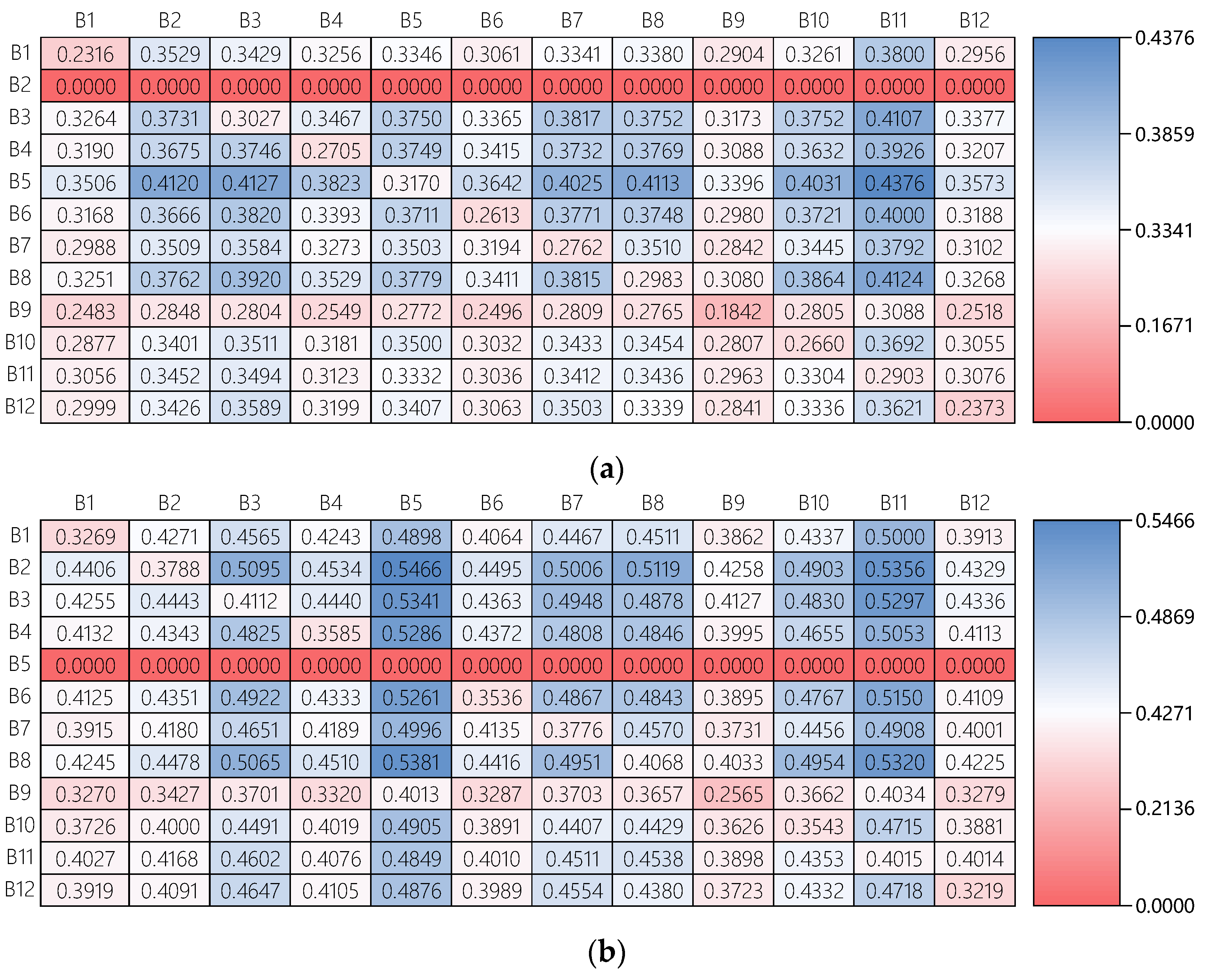Fermatean Fuzzy DEMATEL and MMDE Algorithm for Modelling the Barriers of Implementing Education 4.0: Insights from the Philippines
Abstract
:1. Introduction
2. Literature Review
3. Method
3.1. Preliminaries for the Computational Framework
- Fermatean Fuzzy Sets
- Decision-Making Trial and Evaluation Laboratory
- Maximum Mean De-Entropy Algorithm
3.2. Process Flow of the Proposed Computational Framework
3.3. Case Study Background
3.4. Data Gathering
4. Results and Discussion
4.1. Baseline Results
4.2. Policy Insights
4.3. Scenario Analysis
5. Conclusions and Future Work
- The critical EDUC4 barriers in the baseline case are identified to be related to the lack of training resources (B5), costs (B2), insufficiency of available technologies (B8), skills gap of human resources (B3), knowledge gap (B7), and the complexity of the learning platforms (B11);
- The lack of training resources (B5) for implementing EDUC4 has the most influence on the other barriers, making it the most prominent dispatcher (in terms of frequency) in the baseline case;
- The complexity of learning platforms (B11) for EDUC4 implementation receives the most influence from the dispatchers, making it the most prominent receiver in the baseline case;
- The scenario analysis and the subsequent statistical test show that, while B5 is more prominent in terms of frequency of critical relationships with other EDUC4 barriers, addressing the cost barrier (B2) yields statistically more favorable results in terms of the general (mean) reduction of EDUC4 implementation barriers in the system.
Supplementary Materials
Author Contributions
Funding
Institutional Review Board Statement
Informed Consent Statement
Data Availability Statement
Conflicts of Interest
Appendix A
| Code | Barrier | Brief Description |
|---|---|---|
| B1 | Cybersecurity threat | The threat of information leakage, security attacks, and misusage of technology. |
| B2 | Costly | Implementation of EDUC4 is associated with higher costs (e.g., acquisition of equipment, maintenance). |
| B3 | Skills gap of the human capital | Insufficient knowledge and experience of the human capital in using digital technology for education, including the lack of specific skills (i.e., critical thinking, emotional intelligence). |
| B4 | Apprehensive stakeholders | Apprehension of some stakeholders (i.e., learners, educators, administrators) to EDUC4. |
| B5 | Lack of training resources | The lack of training resources (i.e., facilities, materials) for the professional development of educators. |
| B6 | Lack of collaboration | Lack of collaboration with other sectors (i.e., community, government, other HEIs, industry) is essential in successfully implementing EDUC4. |
| B7 | Knowledge gap for the customization of curriculum design | Current lack of knowledge to create a customized curriculum design to enhance learners’ skills (i.e., creativity, critical thinking) and promote skills-based training. |
| B8 | Insufficient available technologies | Due to the rapid advancement of technology, developing countries cannot catch up with the developed ones. Some technologies might be available in some countries, but not in others. |
| B9 | Health issues | Prolonged exposure to the technology may cause health issues in the physical and mental well-being of the learners and educators. |
| B10 | Time constraint for material preparation | Preparing and teaching in a virtual learning platform requires more time than the traditional one. |
| B11 | Complexity of learning platforms | The challenge that the users (i.e., learners and educators) face on utilizing the virtual learning platform. |
| B12 | Insufficient foundation in basic education | Quality primary education of learners is essential in the implementation of EDUC4 in HEIs. |
References
- Mogoş, R.-I.; Bodea, C.-N.; Dascălu, M.-I.; Safonkina, O.; Lazarou, E.; Trifan, E.-L.; Nemoianu, I.V. Technology enhanced learning for Industry 4.0 engineering education. Rev. Roum. Des. Sci. Tech. Série Électrotech. Énerg. 2018, 63, 429–435. [Google Scholar]
- Oke, A.; Fernandes, F.A.P. Innovations in teaching and learning: Exploring the perceptions of the education sector on the 4th industrial revolution (4IR). J. Open Innov. Technol. Mark. Complex. 2020, 6, 31. [Google Scholar] [CrossRef]
- Miranda, J.; Navarrete, C.; Noguez, J.; Molina-Espinosa, J.-M.; Ramírez-Montoya, M.-S.; Navarro-Tuch, S.A.; Bustamante-Bello, M.-R.; Rosas-Fernández, J.-B.; Molina, A. The core components of education 4.0 in higher education: Three case studies in engineering education. Comput. Electr. Eng. 2021, 93, 107278. [Google Scholar] [CrossRef]
- Vodenko, K.V.; Lyausheva, S.A. Science and education in the form 4.0: Public policy and organization based on human and artificial intellectual capital. J. Intellect. Cap. 2020, 21, 549–564. [Google Scholar] [CrossRef]
- Ciolacu, M.I.; Svasta, P. Education 4.0: AI empowers smart blended learning process with Biofeedback. In Proceedings of the 2021 IEEE Global Engineering Education Conference (EDUCON), Vienna, Austria, 21–23 April 2021; pp. 1443–1448. [Google Scholar]
- Tan, J.P.-L.; Choo, S.S.; Kang, T.; Liem, G.A.D. Educating for twenty-first century competencies and future-ready learners: Research perspectives from Singapore. Asia Pac. J. Educ. 2017, 37, 425–436. [Google Scholar] [CrossRef] [Green Version]
- Indrajit, R.E.; Wibawa, B.; Suparman, A. University 4.0 in developing countries: A case of Indonesia. Int. J. Sociotechnol. Knowl. Dev. 2021, 13, 33–59. [Google Scholar] [CrossRef]
- Ramírez-Montoya, M.S.; Loaiza-Aguirre, M.I.; Zúñiga-Ojeda, A.; Portuguez-Castro, M. Characterization of the Teaching Profile within the Framework of Education 4.0. Future Internet 2021, 13, 91. [Google Scholar] [CrossRef]
- Sovacool, B.K.; Griffiths, S. The cultural barriers to a low-carbon future: A review of six mobility and energy transitions across 28 countries. Renew. Sustain. Energy Rev. 2020, 119, 109569. [Google Scholar] [CrossRef]
- Costan, E.; Gonzales, G.; Gonzales, R.; Enriquez, L.; Costan, F.; Suladay, D.; Atibing, N.M.; Aro, J.L.; Evangelista, S.S.; Maturan, F.; et al. Education 4.0 in Developing Economies: A Systematic Literature Review of Implementation Barriers and Future Research Agenda. Sustainability 2021, 13, 12763. [Google Scholar] [CrossRef]
- Thorell, M.; Fridorff-Jens, P.K.; Lassen, P.; Lange, T.; Kayser, L. Transforming students into digital academics: A challenge at both the individual and the institutional level. BMC Med. Educ. 2015, 15, 48. [Google Scholar] [CrossRef] [PubMed] [Green Version]
- Gabus, A.; Fontela, E. World Problems, An Invitation to Further Thought within the Framework of DEMATEL; Battelle Geneva Research Centre: Geneva, Switzerland, 1972. [Google Scholar]
- Gabus, A.; Fontela, E. Perceptions of the World Problematic: Communication Procedure, Communicating with Those Bearing Collective Responsibility. DEMATEL Report No. 1; Battelle Geneva Research Centre: Geneva, Switzerland, 1973. [Google Scholar]
- Senapati, T.; Yager, R.R. Fermatean fuzzy sets. J. Ambient. Intell. Humaniz. Comput. 2019, 11, 663–674. [Google Scholar] [CrossRef]
- Li, C.-W.; Tzeng, G.-H. Identification of a threshold value for the DEMATEL method using the maximum mean de-entropy algorithm to find critical services provided by a semiconductor intellectual property mall. Expert Syst. Appl. 2009, 36, 9891–9898. [Google Scholar] [CrossRef]
- Halim, M.F.; Shokheh, M.; Harun, M.H.; Ebrahimi, M.; Yusoff, K. The insight of the Industrial Revolution 4.0 in the higher education system. Int. J. Innov. Creat. Chang. 2019, 7, 148–163. [Google Scholar]
- Turcu, C.O.; Turcu, E.C. Industrial Internet of Things as a Challenge for Higher Education. Int. J. Adv. Comput. Sci. Appl. 2018, 9, 55–60. [Google Scholar] [CrossRef]
- World Economic Forum. The Future of Jobs Report 2018. 2018. Available online: https://www3.weforum.org/docs/WEF_Future_of_Jobs_2018.pdf (accessed on 8 November 2021).
- Anito, J.C., Jr.; Morales, M.P.E. The pedagogical model of Philippine STEAM education: Drawing implications for the reengineering of Philippine STEAM learning ecosystem. Univers. J. Educ. Res. 2019, 7, 2662–2669. [Google Scholar] [CrossRef]
- Schwab, K. The Global Competitiveness Report 2018. 2018. Available online: https://www3.weforum.org/docs/GCR2018/05FullReport/TheGlobalCompetitivenessReport2018.pdf (accessed on 8 November 2021).
- Malait, U.; Himang, C.M.; Ocampo, L.; Selerio, E.F., Jr.; Luzano, E.; Caballero, J.H.; Manalastas, R. The Efficacy of Matching Learning Modality in the Teaching-Learning Process: A Case of Teaching Hypothesis Testing. Int. J. Virtual Pers. Learn. Environ. 2022, 12, 1–16. [Google Scholar] [CrossRef]
- Manyika, J.; Chui, M.; Bisson, P.; Woetzel, J.; Dobbs, R.; Bughin, J.; Aharon, D. Unlocking the Potential of the Internet of Things; McKinsey Global Institute: Washington, DC, USA, 2015; pp. 1–14. [Google Scholar]
- Esperanza, P.J.; Himang, C.; Bongo, M.; Selerio, E., Jr.; Ocampo, L. The utility of a flipped classroom in secondary Mathematics education. Int. J. Math. Educ. Sci. Technol. 2021. [Google Scholar] [CrossRef]
- Cheok, M.L.; Wong, S.L. Frog Virtual Learning Environment for Malaysian Schools: Exploring Teachers’ Experience. In Lecture Notes in Educational Technology; Springer: Singapore, 2016; pp. 201–209. [Google Scholar]
- Alakrash, H.M.; Razak, N.A. Education and the Fourth Industrial Revolution: Lessons from COVID-19. Comput. Mater. Contin. 2021, 70, 951–962. [Google Scholar] [CrossRef]
- Buasuwan, P. Rethinking Thai higher education for Thailand 4.0. Asian Educ. Dev. Stud. 2018, 7, 157–173. [Google Scholar] [CrossRef] [Green Version]
- Puthiyamadam, T. How the Meaning of Digital Transformation Has Evolved. 2017. Available online: https://hbr.org/2017/05/how-the-meaning-of-digital-transformation-has-evolved (accessed on 20 September 2021).
- O’Halloran, D.; Kvochko, E. Industrial Internet of Things: Unleashing the Potential of Connected. WEFUSA Industrial Internet Report. 2015. Available online: https://www.weforum.org/press/2015/01/industrial-internet-of-things-unleashing-the-potential-of-connected-products-and-services/ (accessed on 10 November 2021).
- Vu, T.L.A. Building CDIO approach training programmes against challenges of Industrial revolution 4.0 for engineering and technology development. Int. J. Eng. Res. Technol. 2018, 11, 1129–1148. [Google Scholar]
- De Vries, P.; Klaassen, R.; Kamp, A. Emerging technologies in engineering education: Can we make it work? In Proceedings of the 13th International CDIO Conference, Calgary, AB, Canada, 18–22 June 2017; pp. 1–12. [Google Scholar]
- Suhaimi, R.; Rosli, A.N.; Ariffin, A.H.; Muniandy, T.; Wahab, M.H.A. Education 4.0: The impact of computer architecture and organization course on students’ computer anxiety and computer self-efficacy. Int. J. Adv. Trends Comput. Sci. Eng. 2019, 8, 3022–3025. [Google Scholar] [CrossRef]
- Moe, R. The Phenomenal MOOC: Sociocultural Effects of a Marginal Learning Model. In Emergence and Innovation in Digital Learning: Foundations and Applications; Veletsianos, G., Ed.; Athabasca University Press: Athabasca, AB, Canada, 2016; pp. 163–178. [Google Scholar]
- Hrastinski, S. What Do We Mean by Blended Learning? TechTrends 2019, 63, 564–569. [Google Scholar] [CrossRef] [Green Version]
- Estriegana, R.; Medina-Merodio, J.-A.; Barchino, R. Student acceptance of virtual laboratory and practical work: An extension of the technology acceptance model. Comput. Educ. 2019, 135, 1–14. [Google Scholar] [CrossRef]
- Lea, Q.T. Orientation for an Education 4.0: A New Vision for Future Education in Vietnam. Int. J. Innov. Creat. Chang. 2020, 11, 513–526. [Google Scholar]
- Lase, D. Education and industrial revolution 4.0. J. Handayani Pgsd Fip Unimed 2019, 10, 48–62. [Google Scholar]
- Pangandaman, H.K.; Ali, N.D.; Lambayong, J.H.C.; Ergas, M.L.G. Philippine higher education vis-à-vis education 4.0: A scoping review. Int. J. Adv. Res. Publ. 2019, 3, 65–69. [Google Scholar]
- Terrazola, V.E. PH Internet ‘Slowly Getting’ to Top of World Rankings—DICT. Manila Bulletin. 2021. Available online: https://mb.com.ph/2021/09/20/ph-internet-slowly-getting-to-top-of-world-rankings-dict/ (accessed on 10 November 2021).
- Selerio, E.F.; Arcadio, R.D.; Medio, G.J.; Natad, J.R.P.; Pedregosa, G.A. On the complex causal relationship of barriers to sustainable urban water management: A fuzzy multi-criteria analysis. Urban Water J. 2020, 18, 12–24. [Google Scholar] [CrossRef]
- Sekhar, C. The inclusion of sustainability in management education institutions: Assessing critical barriers using the DEMATEL method. Int. J. Sustain. High. Educ. 2020, 21, 200–227. [Google Scholar] [CrossRef]
- Ranjan, R.; Chatterjee, P.; Chakraborty, S. Evaluating performance of engineering departments in an Indian University using DEMATEL and compromise ranking methods. Opsearch 2015, 52, 307–328. [Google Scholar] [CrossRef]
- Alzahrani, A.I.; Al-Samarraie, H.; Eldenfria, A.; Alalwan, N. A DEMATEL method in identifying design requirements for mobile environments: Students’ perspectives. J. Comput. High. Educ. 2018, 30, 466–488. [Google Scholar] [CrossRef]
- Ocampo, L.; Abarca, C.; Abarca, C.; Godes, N.; Pelola, E.; Pensona, M.; Niñofranco, M.; Itallo, C.A.; Paler, C.; Himang, C.; et al. Utilizing DEMATEL for value-embedded e-learning during the COVID-19 pandemic. Educ. Res. Int. 2021, 2021, 9575076. [Google Scholar] [CrossRef]
- Si, S.-L.; You, X.-Y.; Liu, H.-C.; Zhang, P. DEMATEL Technique: A Systematic Review of the State-of-the-Art Literature on Methodologies and Applications. Math. Probl. Eng. 2018, 2018, 1–33. [Google Scholar] [CrossRef] [Green Version]
- Zadeh, L.A. Fuzzy sets. Inf. Control 1965, 8, 338–353. [Google Scholar] [CrossRef] [Green Version]
- Lin, C.-J.; Wu, W.-W. A causal analytical method for group decision-making under fuzzy environment. Expert Syst. Appl. 2008, 34, 205–213. [Google Scholar] [CrossRef]
- Çelikbilek, Y.; Tüylü, A.N.A. Prioritizing the components of e-learning systems by using fuzzy DEMATEL and ANP. Interact. Learn. Environ. 2019. [Google Scholar] [CrossRef]
- Thavi, R.R.; Narwane, V.S.; Jhaveri, R.H.; Raut, R.D. To determine the critical factors for the adoption of cloud computing in the educational sector in developing countries–a fuzzy DEMATEL approach. Kybernetes 2021. [Google Scholar] [CrossRef]
- Tooranloo, H.S.; Mirghafoori, S.H.; Abdolhosseini, M. Analysing determinants of student relationship management implementation: Integration of fuzzy DEMATEL and AHP techniques. Int. J. Educ. Econ. Dev. 2021, 12, 170–191. [Google Scholar] [CrossRef]
- Atanassov, K. Intuitionistic fuzzy sets. Fuzzy Sets Syst. 1986, 20, 87–96. [Google Scholar] [CrossRef]
- Yager, R.R. Pythagorean fuzzy subsets. In Proceedings of the 2013 Joint IFSA World Congress and NAFIPS Annual Meeting (IFSA/NAFIPS), Edmonton, AB, Canada, 24–28 June 2013; pp. 57–61. [Google Scholar]
- Yager, R.R. Generalized Orthopair Fuzzy Sets. IEEE Trans. Fuzzy Syst. 2016, 25, 1222–1230. [Google Scholar] [CrossRef]
- Nikjoo, A.V.; Saeedpoor, M. An intuitionistic fuzzy DEMATEL methodology for prioritising the components of SWOT matrix in the Iranian insurance industry. Int. J. Oper. Res. 2014, 20, 439–452. [Google Scholar] [CrossRef]
- Govindan, K.; Khodaverdi, R.; Vafadarnikjoo, A. Intuitionistic fuzzy based DEMATEL method for developing green practices and performances in a green supply chain. Expert Syst. Appl. 2015, 42, 7207–7220. [Google Scholar] [CrossRef]
- Sangaiah, A.K.; Gao, X.Z.; Ramachandran, M.; Zheng, X. A fuzzy DEMATEL approach based on intuitionistic fuzzy information for evaluating knowledge transfer effectiveness in GSD projects. Int. J. Innov. Comput. Appl. 2015, 6, 203. [Google Scholar] [CrossRef]
- Abdullah, L.; Goh, P. Decision making method based on Pythagorean fuzzy sets and its application to solid waste management. Complex Intell. Syst. 2019, 5, 185–198. [Google Scholar] [CrossRef] [Green Version]
- Yazdi, M.; Nedjati, A.; Zarei, E.; Abbassi, R. A novel extension of DEMATEL approach for probabilistic safety analysis in process systems. Saf. Sci. 2020, 121, 119–136. [Google Scholar] [CrossRef]
- Zeleny, M. Multiple Criteria Decision Making; McGraw Hill: New York, NY, USA, 1981. [Google Scholar]
- Kartam, N.; Tzeng, G.-H.; Teng, J.-Y. Robust contingency plans for transportation investment planning. IEEE Trans. Syst. Man Cybern. 1993, 23, 5–13. [Google Scholar] [CrossRef] [Green Version]
- Mishra, A.R.; Rani, P. Multi-criteria healthcare waste disposal location selection based on Fermatean fuzzy WASPAS method. Complex Intell. Syst. 2021, 7, 2469–2484. [Google Scholar] [CrossRef]
- Organisation for Economic Co-Operation and Development (OECD). PISA 2018 Results (Vol I): What Students Know and Can Do; OECD Publishing: Paris, France, 2019. [Google Scholar] [CrossRef]
- Bernardo, A.B.; Cordel, M.O.; Lucas, R.I.G.; Teves, J.M.M.; Yap, S.A.; Chua, U.C. Using machine learning approaches to explore non-cognitive variables influencing reading proficiency in English among Filipino learners. Educ. Sci. 2021, 11, 628. [Google Scholar] [CrossRef]
- Hanna, N.K.; Knight, P.T. (Eds.) National Strategies to Harness Information Technology: Seeking Transformation in Singapore, Finland, the Philippines, and South Africa; Springer: Berlin/Heidelberg, Germany, 2012. [Google Scholar]
- Llantos, O.E. Cloudification of my.eskwela for e-Governance in Philippine Education. Procedia Comput. Sci. 2017, 109, 680–685. [Google Scholar] [CrossRef]
- Ishak, R.; Mansor, M. The relationship between knowledge management and organizational learning with academic staff readiness for education 4.0. Eurasian J. Educ. Res. 2020, 20, 169–184. [Google Scholar] [CrossRef]






| Linguistic Variables | Influence Score | Equivalent FFSs |
|---|---|---|
| No Influence (NO) | 0 | |
| Very Low (VL) | 1 | |
| Low (L) | 2 | |
| High (H) | 3 | |
| Very High (VH) | 4 |
| Code | Barrier | Category | ||||||
|---|---|---|---|---|---|---|---|---|
| B1 | Cybersecurity threat | 6.35 | 6.00 | 12.35 | 10 | 0.35 | 5 | Net cause |
| B2 | Costly | 7.06 | 6.38 | 13.43 | 5 | 0.68 | 1 | Net cause |
| B3 | Skills gap of the human capital | 6.89 | 7.03 | 13.92 | 2 | −0.14 | 8 | Net effect |
| B4 | Apprehensive stakeholders | 6.78 | 6.36 | 13.14 | 7 | 0.42 | 4 | Net cause |
| B5 | Lack of training resources | 7.50 | 6.85 | 14.35 | 1 | 0.65 | 2 | Net cause |
| B6 | Lack of collaboration | 6.77 | 6.19 | 12.95 | 9 | 0.58 | 3 | Net cause |
| B7 | Knowledge gap for the customization of curriculum design | 6.43 | 6.90 | 13.33 | 6 | −0.47 | 9 | Net effect |
| B8 | Insufficient available technologies | 6.93 | 6.97 | 13.90 | 3 | −0.03 | 7 | Net effect |
| B9 | Health issues | 5.19 | 5.80 | 10.98 | 12 | −0.61 | 11 | Net effect |
| B10 | Time constraint for material preparation | 6.26 | 6.80 | 13.06 | 8 | −0.54 | 10 | Net effect |
| B11 | Complexity of learning platforms | 6.30 | 7.43 | 13.73 | 4 | −1.14 | 12 | Net effect |
| B12 | Insufficient foundation in basic education | 6.29 | 6.03 | 12.32 | 11 | 0.26 | 6 | Net cause |
| Item | Data |
|---|---|
| values | |
| values | |
| values | |
| Baseline | Scenario (a) | Baseline | Scenario (b) | Scenario (a) | Scenario (b) | |
|---|---|---|---|---|---|---|
| Mean | 0.5430 | 0.3338 | 0.5273 | 0.4333 | 0.3338 | 0.4333 |
| Variance | 0.0042 | 0.0019 | 0.0057 | 0.0030 | 0.0019 | 0.0030 |
| Observations | 132 | 132 | 132 | 132 | 132 | 132 |
| df | 230 | 238 | 251 | |||
| t Stat | 30.7897 | 11.5844 | −16.3662 | |||
| p-value (two-tail) | 0.0000 * | 0.0000 * | 0.0000 * | |||
| t Critical (two-tail) | 1.9703 | 1.9700 | 1.9695 |
Publisher’s Note: MDPI stays neutral with regard to jurisdictional claims in published maps and institutional affiliations. |
© 2022 by the authors. Licensee MDPI, Basel, Switzerland. This article is an open access article distributed under the terms and conditions of the Creative Commons Attribution (CC BY) license (https://creativecommons.org/licenses/by/4.0/).
Share and Cite
Gonzales, G.; Costan, F.; Suladay, D.; Gonzales, R.; Enriquez, L.; Costan, E.; Atibing, N.M.; Aro, J.L.; Evangelista, S.S.; Maturan, F.; et al. Fermatean Fuzzy DEMATEL and MMDE Algorithm for Modelling the Barriers of Implementing Education 4.0: Insights from the Philippines. Appl. Sci. 2022, 12, 689. https://doi.org/10.3390/app12020689
Gonzales G, Costan F, Suladay D, Gonzales R, Enriquez L, Costan E, Atibing NM, Aro JL, Evangelista SS, Maturan F, et al. Fermatean Fuzzy DEMATEL and MMDE Algorithm for Modelling the Barriers of Implementing Education 4.0: Insights from the Philippines. Applied Sciences. 2022; 12(2):689. https://doi.org/10.3390/app12020689
Chicago/Turabian StyleGonzales, Gamaliel, Felix Costan, Decem Suladay, Roselyn Gonzales, Lynne Enriquez, Emily Costan, Nadine May Atibing, Joerabell Lourdes Aro, Samantha Shane Evangelista, Fatima Maturan, and et al. 2022. "Fermatean Fuzzy DEMATEL and MMDE Algorithm for Modelling the Barriers of Implementing Education 4.0: Insights from the Philippines" Applied Sciences 12, no. 2: 689. https://doi.org/10.3390/app12020689
APA StyleGonzales, G., Costan, F., Suladay, D., Gonzales, R., Enriquez, L., Costan, E., Atibing, N. M., Aro, J. L., Evangelista, S. S., Maturan, F., Selerio, E., Jr., & Ocampo, L. (2022). Fermatean Fuzzy DEMATEL and MMDE Algorithm for Modelling the Barriers of Implementing Education 4.0: Insights from the Philippines. Applied Sciences, 12(2), 689. https://doi.org/10.3390/app12020689








